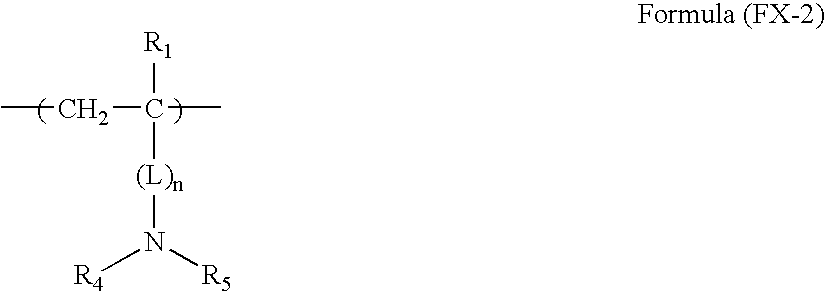Photothermographic material
- Summary
- Abstract
- Description
- Claims
- Application Information
AI Technical Summary
Benefits of technology
Problems solved by technology
Method used
Image
Examples
example 1
[0517] (Preparation of PET Support)
[0518] 1) Film Manufacturing PET having IV (intrinsic viscosity) of 0.66 (measured in phenol / tetrachloroethane=6 / 4 (mass ratio) at 25° C.) was obtained according to a conventional manner using terephthalic acid and ethylene glycol. The product was pelletized, dried at 130° C. for 4 hours, melted at 300° C. Thereafter, the mixture was extruded from a T-die and rapidly cooled to form a non-tentered film.
[0519] The film was stretched along the longitudinal direction by 3.3 times using rollers of different peripheral speeds, and then stretched along the transverse direction by 4.5 times using a tenter machine. The temperatures used for these operations were 110° C. and 130° C., respectively. Then, the film was subjected to thermal fixation at 240° C. for 20 seconds, and relaxed by 4% along the transverse direction at the same temperature. Thereafter, the chucking part was slit off, and both edges of the film were knurled. Then the film was rolled up ...
example 2
1. Preparation of Samples
[0632] Samples No. 21 to No. 30 were each prepared in the same way for preparing the sample No. 3 in Example 1 except that each polymer latex shown in Table 3 was added to the back layer.
2. Performance Evaluation
[0633] About the resultant samples, the same performance evaluation as in Example 1 was made. The results are shown in Table 3. All of the samples exhibited excellent performances in the same manner as in Example 1.
[0634] Furthermore, the curl property and the conveyability thereof were evaluated by the following methods. The results are also shown in Table 3.
1) Curling Property Evaluation
[0635] The samples were each cut into a 25×35 cm sheet. The sheet was subjected to the above-mentioned thermal development. Thereafter, the sheet was put onto a flat stand at 25° C. and 80% RH in the state that the image forming layer surface thereof was faced upward. About each of the four corners of the sheet, the height thereof from the stand was measure...
PUM
 Login to View More
Login to View More Abstract
Description
Claims
Application Information
 Login to View More
Login to View More - Generate Ideas
- Intellectual Property
- Life Sciences
- Materials
- Tech Scout
- Unparalleled Data Quality
- Higher Quality Content
- 60% Fewer Hallucinations
Browse by: Latest US Patents, China's latest patents, Technical Efficacy Thesaurus, Application Domain, Technology Topic, Popular Technical Reports.
© 2025 PatSnap. All rights reserved.Legal|Privacy policy|Modern Slavery Act Transparency Statement|Sitemap|About US| Contact US: help@patsnap.com



